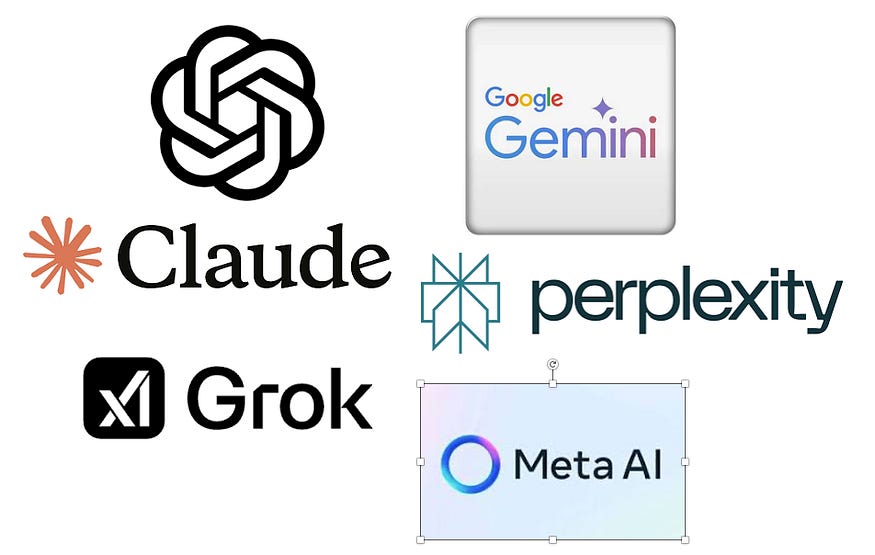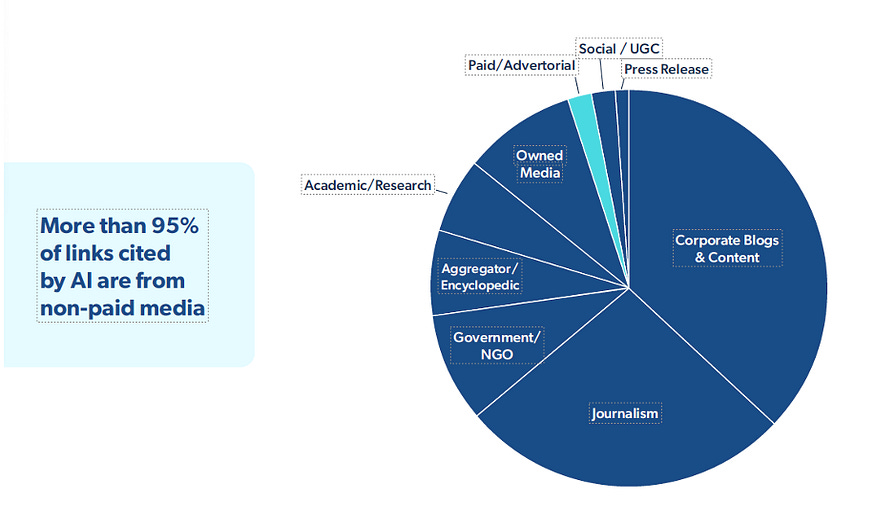The New Gatekeepers
Why and How Content Creators Should Adapt for AI
About 18 months ago, in a PR strategy meeting with a client, a new member of the corporate communications staff had what she thought was an epiphany: “We need to raise our profile in the LLMs.” And to do so, she reasoned, “we must generate more branded news coverage.”
Hmmm, yes and no, but not so fast.
The playbook that defined public relations for decades is being rewritten in real time. While traditional earned media relations remains valuable, a seismic shift is underway — one that requires PR professionals to fundamentally rethink how they create, distribute, and measure content in an age when AI algorithms, and LLMs in particular, increasingly serve as the primary information brokers between brands and consumers. We’re talking AEO and GEO: Answer Engine Optimization and Generative Engine Optimization.
A recent Muck Rack study analyzing over one million AI-generated citations reveals something both surprising and sobering: what your brand stands for matters less than whether AI systems choose to amplify it. Citations profoundly shape AI responses — enable them, and the answer changes entirely. AI systems are making editorial decisions about what to reference, and those decisions determine whether your company is part of the conversation or not.
The Shift in Web Physics
The old internet physics — search engines visit your site and send visitors in return — is collapsing. On a recent visit to New York, my Mom’s 80-year-old cousin, visiting from Cincinnati, kept pulling out her iPhone to ask ChatGPT questions.
Seth Besmertnik, CEO of Conductor, explained to me and to those at the C3 2025 conference that the economics have inverted. ChatGPT crawls websites roughly 60,000 times and sends back just one visitor. Anthropic bots crawl approximately 1,500 times per single referral. The implication: website traffic has become the wrong success metric.
As Catherine Perloff reported in The Information, this is why companies from Mexican hotel chain Tafer Hotels & Resorts to Fortune 500 firms are seeing 25% traffic declines, without corresponding revenue hits (for now). Hotel executives now recognize that visitors arriving through AI systems spend more time on sites and are more likely to complete purchases than casual Google searchers. Traffic quality, not volume, is what matters.
The real opportunity lies in content impressions within AI and search interfaces. As Besmertnik put it: “Every time someone is looking for something, a little window in their mind opens — an opportunity for organizations to inject information, wisdom, knowledge.” The question is no longer “How do we drive traffic to our website?” It’s “How do we ensure our content is cited as authoritative when AI answers questions about our industry?”
“There’s not enough content for AI because the way people use AI is very different than how they use Google.” Users don’t search for “best running shoes.” They ask: “What’s the best running shoe for someone with flat feet who can’t wear Nikes?” That specificity demands fundamentally different content architecture.
Reverse-Engineer the Algorithm
Many PR pros don’t realize that you can actually ask ChatGPT to show you its algorithm. Eric Schwartzman, a New York-based digital marketing consultant specializing in AI optimization, explained in a conversation that the process is pretty straightforward.
When a client wasn’t appearing in ChatGPT’s answers and his competitors were, Schwartzman asked the AI platform directly: “What criteria did you use to rank competitors in this vertical?” ChatGPT provided specific weightings: 25% board certification, 20% review quality and quantity, 15% experience and case volume, and so on. Schwartzman then examined top-ranked competitors and found their homepages contained all these elements — using those exact words.
The insight: LLMs aren’t mysterious black boxes. They’re scraping content voraciously for structural patterns and topical signals. Your job is to feed them what they’re looking for.
Schwartzman recommends starting with schema markup, the standardized metadata language at schema.org. “LLMs are scraping schema,” he noted. “That’s where they’re getting everything right now.” Create an FAQ on your website — ask ChatGPT to generate common questions about your industry, then answer them comprehensively. Publish that FAQ with schema markup in the background. This makes your content machine-readable and optimizable.
The strategy involves three types of keywords: variations (how people search differently for the same concept), entities (Wikipedia-recognized topics), and LSI keywords (latent semantic indexing — thematically related terms). Use these strategically across your owned content.
Courtesy of Muck Rack
Journalism Still Rules
Here’s where traditional PR meets new reality. The Muck Rack study found that over 95% of links cited by AI systems are from non-paid media. More specifically, 27% of AI citations come from journalistic content. For opinion-based or recency-focused prompts, that number jumps to 49%.
This is music to PR practitioners’ ears — if they adapt. It suggests that the core skill of PR — securing earned media coverage — remains crucial. But there’s a catch. Not all earned media is created equal in the eyes of AI systems. High-authority outlets like Reuters, Axios, and the Financial Times appear frequently in citations, but consistency varies significantly by industry.
The implication: blanket media placement strategies won’t cut it. PR teams must identify which publications AI systems actually prioritize for their specific industry and topic.
Building the Content Pyramid
Sarah Evans’ “Inside-Out Story” framework remains a strategic backbone: owned media first, then earned, then AI visibility. Start with long-form anchor articles on your website structured for AI consumption. But Schwartzman adds critical specificity: this content must reside on your owned properties and then be amplified through all available channels.
Evans emphasizes the importance of framing headlines to reflect real prompts: “How can global brands prepare for AI-driven hiring?” rather than abstract positioning. Each anchor article should be supported by schema markup — FAQ and how-to formats are particularly valuable — and internally linked to supporting pages and glossary content.
Besmertnik’s research shows the most successful brands have content “widely cited by AI platforms and referenced in thousands of prompts.” Penn Medicine focused on lower-funnel content that AI picked up. LabCorp created proprietary research that became widely cited. Their success came from producing content at scale — not just one landing page, but dozens of pieces addressing granular personas and decision stages.
The distribution strategy is holistic. Schwartzman emphasized: “Before I spend time inviting people over, I want to clean up my house first.” Optimize owned media. Then build roads back to that content through social platforms affiliated with AI systems. Reddit and Wikipedia have favored status with LLMs. LinkedIn is affiliated with Microsoft and ChatGPT. Facebook data feeds Zuckerberg’s AI models. The principle: introduce information onto platforms where the LLMs you’re targeting actually source training data.
Focus on the Dominant Platforms
Ignore the noise about Claude, Grok, and Perplexity for now. As Besmertnik stated bluntly: “If you’re a brand, you should not be measuring or caring about how you show up in Grok or Claude. What you should care about is Google and ChatGPT.” These two command 99% of market share for consumer decision-making. That’s where your resources should flow.
This doesn’t diminish other models’ value for creative or utility purposes, but it clarifies where PR investment should flow. While your content team might use Claude to draft communications or Perplexity to research industry trends, your visibility strategy must prioritize the platforms where actual customers make decisions.
That said, the most dominant platform, ChatGPT, just changed the way it recognizes and recommends brands, as Profound’s Josh Blyskal noted in his thoughtful LinkedIn post about the structural change that took place on October 18. He wrote:
We pulled millions of ChatGPT responses, [sic] here’s what’s going on:
1. The avg. number of brands mentioned per response dropped from 6 to 3.5
2. At the same time, average brand visibility fell 31%
3. The competitive gap between 1st and 10th compressed by 23%.
The New Metrics
Besmertnik concluded his C3 presentation with a critical insight: “Priorities are measured by where you put money, time, effort.” Organizations winning at AI visibility aren’t tinkering incrementally. They’re reallocating budgets toward content production and distribution.
LabCorp shifted reporting from traditional KPIs (impressions, visitors) to: mentions, citations, and market share for key topics in AI search.
This represents a fundamental PR principle finally gaining leverage: your company doesn’t own the narrative, but it can own the authority and wisdom in your space. And when AI systems look for that wisdom, they should find you.
Industry veteran Peter Himler is the founding principal of Flatiron Communications, a NYC-based PR and digital media consultancy.






